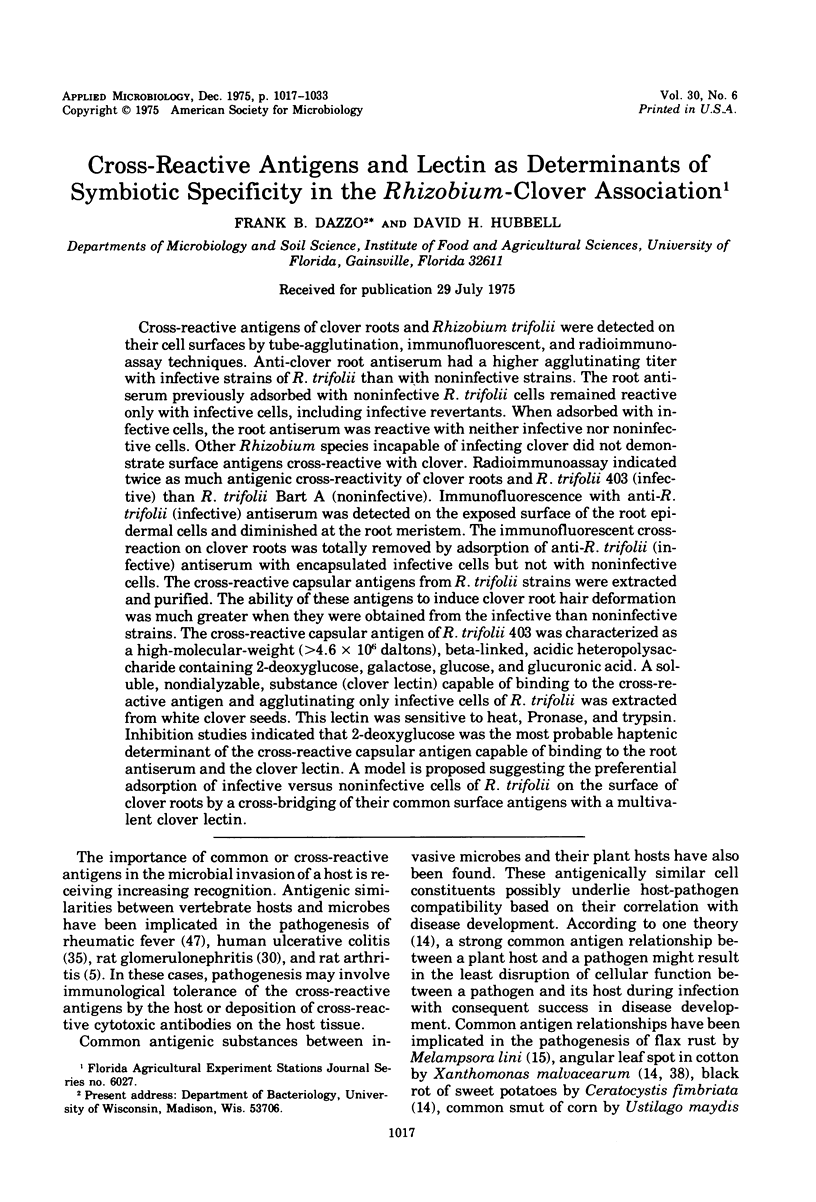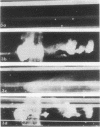Abstract
Cross-reactive antigens of clover roots and Rhizobium trifolii were detected on their cell surfaces by tube agglutination, immunofluorescent, and radioimmunoassay techniques. Anti-clover root antiserum had a higher agglutinating titer with infective strains of R. trifolii than with noninfective strains. The root antiserum previously adsorbed with noninfective R. trifolii cells remained reactive only with infective cells, including infective revertants. When adsorbed with infective cells, the root antiserum was reactive with neither infective nor noninfective cells. Other Rhizobium species incapable of infecting clover did not demonstrate surface antigens cross-reactive with clover. Radioimmunoassay indicated twice as much antigenic cross-reactivity of clover roots and R. trifolii 403 (infective) than R. trifolii Bart A (noninfective). Immunofluorescence with anti-R. trifolii (infective) antiserum was detected on the exposed surface of the root epidermal cells and diminished at the root meristem. The immunofluorescent crossreaction on clover roots was totally removed by adsorption of anti-R. trifolii (infective) antiserum with encapsulated infective cells but not with noninfective cells. The cross-reactive capsular antigens from R. trifolii strains were extracted and purified. The ability of these antigens to induce clover root hair deformation was much greater when they were obtained from the infective than noninfective strains. The cross-reactive capsular antigen of R. trifolii 403 was characterized as a high-molecular-weight (greater than 4.6 times 10(6) daltons), beta-linked, acidic heteropolysaccharide containing 2-deoxyglucose, galactose, glucose, and glucuronic acid. A soluble, nondialyzable, substance (clover lectin) capable of binding to the cross-reactive antigen and agglutinating only infective cells of R. trifolii was extracted from white clover seeds. This lectin was sensitive to heat, Pronase, and trypsin. inhibition studies indicated that 2-deoxyglucose was the most probable haptenic determinant of the cross-reactive capsular antigen capable of binding to the root antiserum and the clover lectin. A model is proposed suggesting the preferential adsorption of infective versus noninfective cells of R. trifolii on the surface of clover roots by a cross-bridging of their common surface antigens with a multivalent clover lectin.
Full text
PDF
















Images in this article
Selected References
These references are in PubMed. This may not be the complete list of references from this article.
- BARKER S. A., BOURNE E. J., WHIFFEN D. H. Use of infrared analysis in the determination of carbohydrate structure. Methods Biochem Anal. 1956;3:213–245. doi: 10.1002/9780470110195.ch7. [DOI] [PubMed] [Google Scholar]
- Bohlool B. B., Schmidt E. L. Lectins: a possible basis for specificity in the Rhizobium--legume root nodule symbiosis. Science. 1974 Jul 19;185(4147):269–271. doi: 10.1126/science.185.4147.269. [DOI] [PubMed] [Google Scholar]
- Cahill J. F., Cole B. C., Wiley B. B., Ward J. R. Role of Biological Mimicry in the Pathogenesis of Rat Arthritis Induced by Mycoplasma arthritidis. Infect Immun. 1971 Jan;3(1):24–35. doi: 10.1128/iai.3.1.24-35.1971. [DOI] [PMC free article] [PubMed] [Google Scholar]
- Chadha K. C., Srivastava B. I. Evidence for the Presence of Bacteria-specific Proteins in Sterile Crown Gall Tumor Tissue. Plant Physiol. 1971 Aug;48(2):125–129. doi: 10.1104/pp.48.2.125. [DOI] [PMC free article] [PubMed] [Google Scholar]
- Charudattan R., Hubbell D. H. The presence and possible significance of cross-reactive antigens in Rhizobium--legume associations. Antonie Van Leeuwenhoek. 1973 Nov;39(4):619–627. doi: 10.1007/BF02578905. [DOI] [PubMed] [Google Scholar]
- Dazzo F. B., Hubbell D. H. Antigenic differences between infective and noninfective strains of Rhizobium trifolii. Appl Microbiol. 1975 Aug;30(2):172–177. doi: 10.1128/am.30.2.172-177.1975. [DOI] [PMC free article] [PubMed] [Google Scholar]
- Doubly J. A., Flor H. H., Clagett C. O. Relation of Antigens of Melampsora lini and Linum usitatissimum to Resistance and Susceptibility. Science. 1960 Jan 22;131(3395):229–229. doi: 10.1126/science.131.3395.229. [DOI] [PubMed] [Google Scholar]
- Dudman W. F. Detection of acidic polysaccharides in gels by DEAE-dextran. Anal Biochem. 1972 Apr;46(2):668–673. doi: 10.1016/0003-2697(72)90338-7. [DOI] [PubMed] [Google Scholar]
- FAHRAEUS G. The infection of clover root hairs by nodule bacteria studied by a simple glass slide technique. J Gen Microbiol. 1957 Apr;16(2):374–381. doi: 10.1099/00221287-16-2-374. [DOI] [PubMed] [Google Scholar]
- Hamblin J., Kent S. P. Possible role of phytohaemagglutinin in Phaseolus vulgaris L. Nat New Biol. 1973 Sep 5;245(140):28–30. doi: 10.1038/newbio245028a0. [DOI] [PubMed] [Google Scholar]
- LOWRY O. H., ROSEBROUGH N. J., FARR A. L., RANDALL R. J. Protein measurement with the Folin phenol reagent. J Biol Chem. 1951 Nov;193(1):265–275. [PubMed] [Google Scholar]
- Li D., Hubbell D. H. Infection thread formation as a basis of nodulation specificity in Rhizobium--strawberry clover associations. Can J Microbiol. 1969 Oct;15(10):1133–1136. doi: 10.1139/m69-206. [DOI] [PubMed] [Google Scholar]
- MARKOWITZ A. S., ARMSTRONG S. H., Jr, KUSHNER D. S. Immunological relationships between the rat glomerulus and nephritogenic streptococci. Nature. 1960 Sep 24;187:1095–1097. doi: 10.1038/1871095a0. [DOI] [PubMed] [Google Scholar]
- Napoli C., Dazzo F., Hubbell D. Production of cellulose microfibrils by Rhizobium. Appl Microbiol. 1975 Jul;30(1):123–131. doi: 10.1128/am.30.1.123-131.1975. [DOI] [PMC free article] [PubMed] [Google Scholar]
- Perlmann P., Hammarström S., Lagercrantz R., Gustafsson B. E. Antigen from colon of germfree rats and antibodies in human ulcerative colitis. Ann N Y Acad Sci. 1965 Jun 30;124(1):377–394. doi: 10.1111/j.1749-6632.1965.tb18972.x. [DOI] [PubMed] [Google Scholar]
- Vaught R. M., Bleiweis A. S. Antigens of Streptococcus mutans. II. Characterization of an antigen resembling a glycerol teichoic acid in walls of strain BHT. Infect Immun. 1974 Jan;9(1):60–67. doi: 10.1128/iai.9.1.60-67.1974. [DOI] [PMC free article] [PubMed] [Google Scholar]
- Zabriskie J. B. Mimetic relationships between group A streptococci and mammalian tissues. Adv Immunol. 1967;7:147–188. doi: 10.1016/s0065-2776(08)60128-5. [DOI] [PubMed] [Google Scholar]







